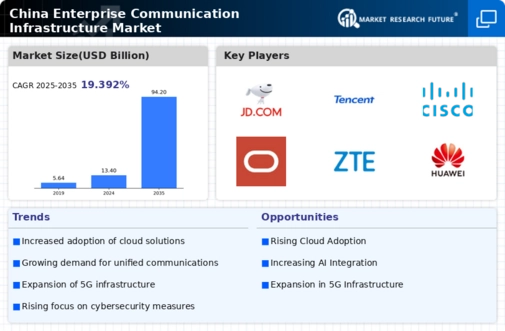Rapid Digital Transformation
The enterprise communication-infrastructure market in China is experiencing a surge due to rapid digital transformation across various sectors. Organizations are increasingly adopting digital tools to enhance operational efficiency and improve communication. This shift is evidenced by a reported growth rate of 15% in digital communication solutions in 2025. Companies are investing in advanced communication technologies to streamline workflows and foster collaboration among remote teams. As businesses transition to digital-first strategies, the demand for robust communication infrastructure is likely to escalate, driving market growth. Furthermore, the Chinese government's initiatives to promote digital economy development are expected to further bolster investments in this sector, indicating a promising outlook for the enterprise communication-infrastructure market in the coming years.
Increased Remote Work Culture
The rise of remote work culture in China has significantly impacted the enterprise communication-infrastructure market. As organizations adapt to flexible work arrangements, the need for reliable communication tools has become paramount. A survey indicates that 70% of companies in China plan to maintain remote work policies, which necessitates the implementation of effective communication solutions. This trend is pushing enterprises to invest in cloud-based communication platforms that facilitate seamless collaboration among distributed teams. The growing reliance on video conferencing, instant messaging, and collaborative tools is likely to drive demand for advanced communication infrastructure. Consequently, the enterprise communication-infrastructure market is poised for growth as businesses seek to enhance connectivity and productivity in a remote work environment.
Rising Cybersecurity Concerns
As the enterprise communication-infrastructure market evolves in China, rising cybersecurity concerns are becoming a significant driver of market growth. With increasing incidents of cyber threats, organizations are prioritizing secure communication solutions to protect sensitive information. A report suggests that 75% of enterprises in China are investing in advanced security measures for their communication infrastructure. This heightened focus on cybersecurity is prompting businesses to seek solutions that offer robust encryption, secure access controls, and compliance with regulatory standards. Consequently, the enterprise communication-infrastructure market is likely to see a surge in demand for secure communication technologies, as organizations strive to mitigate risks and safeguard their digital assets.
Government Initiatives and Support
Government initiatives aimed at enhancing digital infrastructure in China are playing a crucial role in shaping the enterprise communication-infrastructure market. The Chinese government has launched various programs to promote technological innovation and digital transformation, which includes substantial funding for communication infrastructure projects. In 2025, it is estimated that government investments in digital communication technologies will reach approximately $10 billion. These initiatives not only provide financial support but also create a favorable regulatory environment for businesses to adopt advanced communication solutions. As a result, the enterprise communication-infrastructure market will benefit from increased public sector collaboration and investment, fostering growth and innovation in the industry.
Growing Demand for Unified Communication Solutions
The enterprise communication-infrastructure market is witnessing a growing demand for unified communication solutions in China. Businesses are increasingly recognizing the value of integrating various communication channels into a single platform to enhance efficiency and user experience. A recent study indicates that 60% of enterprises are prioritizing the adoption of unified communication systems to streamline operations. This trend is driven by the need for seamless collaboration among employees, regardless of their location. As organizations seek to improve communication workflows, the enterprise communication-infrastructure market is expected to expand, with vendors offering innovative solutions that cater to this demand. The integration of voice, video, and messaging services into cohesive platforms is likely to become a key focus area for market players.

















Leave a Comment